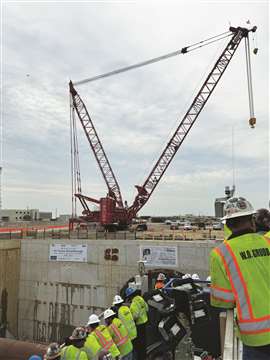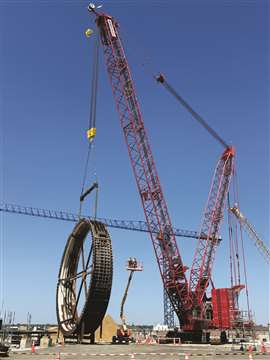How ‘Mary’ is digging deep for Virginia’s biggest highway project
12 August 2024
 W.O. Grubb’s Manitowoc MLC650 sits above the tunnel, waiting on the tunnel boring machine to break through the headwall.
W.O. Grubb’s Manitowoc MLC650 sits above the tunnel, waiting on the tunnel boring machine to break through the headwall.
On April 17, 2024, a tunnel boring machine (TBM) known as “Mary,” broke through a headwall, completing the first tunnel that is a part of the Hampton Roads Bridge Tunnel Expansion (HRTAC) project. The largest highway construction project in Virginia’s history, estimated to cost $9.3 billion, the project is set for completion in early 2027.
A cadre of construction crews were on hand to see Mary emerge, busting through the barrier with its rotating head grinding away amid the rock, dirt and dust.
Waiting on Mary was W.O. Grubb’s Manitowoc MLC650, which was sitting above the tunnel opening, waiting to assist in the turnaround of the TBM. After emerging into a receiving pit at North Island, crews used nitrogen tables to raise, slide and turn “Mary” 180 degrees, according to Virginia Department of Transportation.
76 truck loads
The pre-owned Manitowoc MLC650 was dispatched to the site by Atlantic Coast Cranes & Machinery, located in Ashland, VA. The 772-ton capacity crawler with the VPC Max Superlift attachment was delivered in 76 truckloads in April 2024.
“ACC was honored to be awarded the contract to supply the Manitowoc MLC650 with VPC Max for this project by W.O. Grubb, and delighted to work with Bill Grubb and his world-class organization,” said Wally Jones, ACC president.
After some quick maintenance, Mary made a U-turn to begin the second tunnel. This project will widen the four-lane segments along nearly 10 miles of the I-64 corridor in Norfolk and Hampton, with new twin tunnels across the harbor. The expansion will increase capacity and ease major traffic, according to Virginia DOT.
 Atlantic Coast Cranes & Equipment sold the used 772-ton Manitowoc MLC650 with VPC Max Superlift to W.O. Grubb for the Virginia Hampton Roads Bridge Tunnel expansion.
Atlantic Coast Cranes & Equipment sold the used 772-ton Manitowoc MLC650 with VPC Max Superlift to W.O. Grubb for the Virginia Hampton Roads Bridge Tunnel expansion.
Grinding away
“Mary” measures 46 feet in diameter and is 300 feet long. She was launched from the South Island (Norfolk side) in April 2023 and bored about 50 feet per day. Built specifically for this project in Germany, Mary cost about $70 million, which includes construction, shipping and assembly costs. Mary is located about 173 feet below the harbor’s surface. The TBM excavates tunnels with a circular cross-section through the soil. It took 13 months to build the first tunnel.
Mary was named by the Saint Gregory the Great Catholic School, which won first place in the TBM Naming Contest. She is named for Mary Jackson, a mathematician and aerospace engineer at NASA, noted for her pioneering role of an African America woman in the field of science and engineering and her contributions to the space program. Jackson was from Hampton, Virginia, where the HRTAC project is located.





